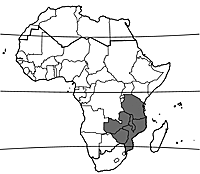Cryptolepis obtusa (PROTA)
Introduction |
Cryptolepis obtusa N.E.Br.
- Protologue: Kew Bull.: 110 (1895).
- Family: Asclepiadaceae (APG: Apocynaceae)
- Chromosome number: 2n = 22
Origin and geographic distribution
Cryptolepis obtusa occurs in Tanzania, Malawi, Zambia, Zimbabwe, Mozambique and also in South Africa.
Uses
In Tanzania a root decoction is drunk to treat schistosomiasis and accumulation of fluids in the lymphatic system. Breasts are washed with a leaf decoction to increase milk production. Leaf sap is drunk to treat hiccup. In Mozambique leaf sap is applied to wounds as a disinfectant. A root decoction and leaf sap are drunk to treat gonorrhoea, abdominal pain and to prevent abortion.
Properties
The major constituents isolated from the ethanolic leaf extracts are the flavonoids: quercetin, rutin, quercitrin as well as chlorogenic acid. Weak antibacterial activity of the ethanolic extract has been reported against Staphylococcus aureus and Vibrio cholerae. Individual components of the extract, upon testing, were inactive against a range of bacteria. From the roots several diglycosylated steroidal alkaloids were isolated.
Description
Glabrous liana up to 4 m long. Leaves opposite, simple and entire; stipules absent; petiole 4–10 mm long; blade oblong, 2–7.5 cm × 0.8–2.8 cm, base rounded to cuneate, apex obtuse, retuse or emarginate, mucrunate. Inflorescence an axillary cyme up to 5 cm long, laxly 6–10-flowered, often arranged in elongated leafless narrow panicles 7.5–30 cm long at the end of lateral shoots; peduncle up to 2.5 cm long; bracts lanceolate, up to 2 mm long. Flowers bisexual, regular, 5-merous; pedicel 2–4 mm long; sepals ovate, c. 2 mm long, acuminate, subacute; corolla tube campanulate, c. 2 mm long, lobes linear-lanceolate, c. 6 mm long, acute; corona lobes lanceolate, c. 1 mm long, fleshy; stamens with free filaments, anthers triangular, acuminate, fused to stigmatic head; ovary semi-inferior, 2-celled, style columnar. Fruit a pair of spreading follicles, each cylindrical, 7.5–22.5 cm × 5–6 mm, acuminate, reflexed when ripe, many-seeded. Seeds oblong-ovoid, c. 6 mm long, flattened, smooth, with minute warts, blackish brown, with a coma of whitish hairs.
Other botanical information
Cryptolepis belongs to subfamily Periplocoideae. It comprises about 30 species in Africa, Asia and Australia. The majority of the species occur in East Africa and on Socotra (Yemen). Several other Cryptolepis species in East and southern Africa are used medicinally.
Cryptolepis africana
Cryptolepis africana (Bullock) Venter & R.L.Verh. (synonym: Cryptolepis sinensis Merr. subsp. africana Bullock) occurs in Kenya and Tanzania. In Tanzania a root decoction is drunk as an aphrodisiac. The breasts are washed with leaf sap and a root decoction is drunk as a galactagogue.
Cryptolepis hypoglauca
Cryptolepis hypoglauca K.Schum. occurs in Cameroon, Kenya and Tanzania. In Kenya the root is chewed as an aphrodisiac.
Cryptolepis orbicularis
Cryptolepis orbicularis Chiov. is endemic to Somalia. Seeds, sometimes ground in water, are taken to treat stomach-ache.
Ecology
Cryptolepis obtusa occurs in river valleys and shrubland, from sea-level up to 2000 m altitude.
Genetic resources
There are no indications that Cryptolepis obtusa is threatened by genetic erosion.
Prospects
Cryptolepis obtusa will probably remain of local importance as a medicinal plant, although the isolated compounds from the roots and leaves could have interesting pharmacological properties.
Major references
- Brown, N.E., 1902–1904. Asclepiadaceae. In: Thiselton-Dyer, W.T. (Editor). Flora of tropical Africa. Volume 4(1). Lovell Reeve & Co, London, United Kingdom. pp. 231–503.
- Haerdi, F., 1964. Die Eingeborenen-Heilpflanzen des Ulanga-Distriktes Tanganjikas (Ostafrika). In: Haerdi, F., Kerharo, J. & Adam, J.G. (Editors). Afrikanische Heilpflanzen / Plantes médicinales africaines. Acta Tropica Supplementum 8: 1–278.
- Jansen, P.C.M. & Mendes, O., 1984. Plantas medicinais, seu uso tradicional em Moçambique. Volume 2. Gabinete de Estudos de Medicina Tradicional, Ministério da Saúde, Maputo, Moçambique. 260 pp.
Other references
- Neuwinger, H.D., 2000. African traditional medicine: a dictionary of plant use and applications. Medpharm Scientific, Stuttgart, Germany. 589 pp.
- Paulo, A. & Houghton, P.J., 2003. Chemotaxonomic analysis of the genus Cryptolepis. Biochemical Systematics and Ecology 31: 155–166.
- Paulo, A., Gomes, E.T., Duarte, A., Perrett, S. & Houghton, P.J., 1997. Chemical and antimicrobial studies on Cryptolepis obtusa leaves. Fitoterapia 68: 558–559.
- Paulo, A., Jimeno, M.L., Gomes, E.T. & Houghton, P.J., 2000. Steroidal alkaloids from Cryptolepis obtusa. Phytochemistry 53: 417–422.
- Venter, H.J.T. & Verhoeven, R.L., 2007. A re-appraisal of Cryptolepis sinensis subsp. africana (Apocynaceae: Periplocoideae) and a description of the pollen apparatus. South African Journal of Botany 73(1): 40–42.
Author(s)
- G.H. Schmelzer, PROTA Network Office Europe, Wageningen University, P.O. Box 341, 6700 AH Wageningen, Netherlands
Correct citation of this article
Schmelzer, G.H., 2010. Cryptolepis obtusa N.E.Br. In: Schmelzer, G.H. & Gurib-Fakim, A. (Editors). PROTA (Plant Resources of Tropical Africa / Ressources végétales de l’Afrique tropicale), Wageningen, Netherlands. Accessed 31 March 2025.
- See the Prota4U database.

